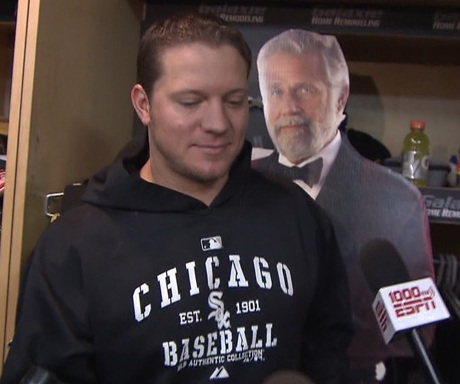It doesn’t always hold your attention, but when it does, it prefers Yankees/Red Sox.
Baseball is on it’s way out, say some. The complaints are myriad: it’s unsustainable; the modern market demands a quicker hitting product; there’s no groundswell of interest amongst da youtes; and, mostly, it’s boring. Maybe. But with baseball, beauty is in the details. Last night’s edition of Sunday Night Baseball on ESPN featured a comprehensive assortment of everything that makes a telecast great. Maybe it wasn’t enough to captivate a faltering audience, but as far as a baseball game is goes it was a classic.
The early innings saw both starters trade wavering passes across a high wire, but each managed a quality start. Power balanced precision throughout. In the top of the second the Sox lost a man at the plate, casualty of Brett Gardner’s cannon; in the bottom of the eighth Jonathan Herrera absolutely pilfered a sure hit from Kelley Johnson, turning in a Web Gem and proving the shift in one graceful motion. Carlos Beltran delivered an easy-swinging two run homer in the third; in the sixth Mike Napoli offered a majestic drive of his own to pull Boston within one. Daniel Nava and Ichiro had Vine-worthy evenings by the wall in right, while Dean Anna and Napoli flashed leather in the infield.
There were oddities galore. With men on second and third and one out, Alfonso Soriano failed to drive in a run with a deep flyball to center, as Jackie Bradley Jr. turned your conventional 8-5 double play, thwarting Jacoby Ellsbury’s ambitious advance to third before Beltran crossed the plate (the Elias Sports Bureau assures me this is uncommon). At one point Ryan Roberts went first to third on a single scored 1-4-5. Injuries necessitated two positional debuts. In the fourth, Beltran replaced Fancisco Cervelli (hamstring) at first base for the Yankees; with Dustin Pedroia’s wrist issue thinning the bench, and facing an eighth inning bases-loaded-two-out-down-by-one matchup with righty David Phelps, John Farrell opted to pinch hit lefty Mike Carp for third baseman Roberts, sending Carp to man the hot corner in the bottom of the inning. Somewhere in the interim John Kruk and Dan Shulman spent more than a minute of airtime observing and subsequently eviscerating an obese, sleeping spectator.
Perhaps of more significance–and certainly encouraging for the legacy of the sport–was a pointedly harmonious balance between technology and the human element. After Joe Girardi won a challenge overturning a pivotal inning-ending double play, Farrell came out, got hot, and got run–just like the old days, except he was arguing on the field about a video that was judged in an office at another address… Regardless, it was refreshing. Further nostalgia came courtesy of a testy home plate umpire with an elastic strike zone. While unsubstantiated displeasure was shown on the field, modern technology graced our living rooms with the definitive evidence that the home plate ump indeed sucked, and the ruling on the challenge was correct. Yin and Yang appeared in accord.
It’s undoubtedly true that the play to play monotony of baseball is antithetical to the trend of modern media. But there is beauty there nonetheless. Maybe it just isn’t fast enough, in terms of action or duration. Maybe sabermetrics and serious $takes have turned it too intellectual for the times. Maybe the following analogy is emblematic of that truth, but like a Mandelbrot set, the deeper one delves the more complex and fascinating baseball becomes. Whether it lasts as a mass-appealing product and a television juggernaut remains to be seen, but no matter what, it will always be the most intricate, beautiful of games.
-Ari Glantz















